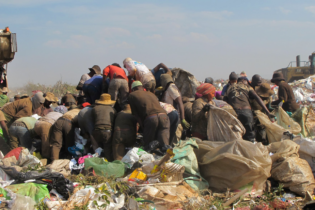A study conducted by a group of scientists has revealed that there are serious health implications for residents living close to waste disposal sites.
The team, led by University of KwaZulu-Natal (UKZN) vice-chancellor Rob Slotow, found that those residents who live within a 5km radius of a dumping site are more susceptible to chronic illnesses such as asthma, tuberculosis and depression. Slotow says the 2020 study, published in The Lancet Planetary Health journal, was based on data drawn from more than 30 000 people who were surveyed as part of the South African National Income Dynamics Study (SA-Nids) between 2008 and 2015. The data included the health status of participants living close to waste sites, as determined by data captured in the South African National Income Dynamics Study. The research was co-authored by Andrew Mitsuaki Tomita of the UKZN school of nursing and public health, Frank Tanser of the African Health Research Institute at UKZN, Diego Cuadros from the University of Cincinnati in the United States and Jonathan Burns, an honorary professor of psychiatry at the University of Exeter in the United Kingdom and the former head of psychiatry at UKZN The study did not take illegal waste sites into consideration and focused solely on licensed sites. There are more than 1 000 licensed waste disposal sites across South Africa. What the study found Between 2008 and 2015, researchers observed a substantial increase in exposure of households to waste sites. The median distance of households to waste sites decreased from 68km to only 8,5km over the study period.By 2015, more than half the people registered in the SA-Nids study were living within 10km of a waste site, while more than 35% lived within 5km of a dump.
They calculated that people had a 41% higher risk of developing asthma, an 18% higher risk of contracting TB, a 25% higher chance of having diabetes and an 8% greater chance of suffering from depression compared with those who live further than 5km from a waste site. The study also showed a rapid and unsustainable increase in the number of registered waste sites nationwide. The data suggests that the number of sites grew from at least 42 sites in 2008 to 280 sites in 2010, 519 in 2012 and 1 086 in 2015. Slotow says that while there were probably many more than 42 waste dumps in 2008, there has nevertheless been a rapid increase in the number of dumps established in recent years. Conclusions A 2018 report by the Department of Environment, Forestry and Fisheries showed that South Africa generates roughly 54,2 million tons of general waste per year. Of this, only 10% is properly recycled or reused, with the remaining 90% being “landfilled or dumped”. A second report suggests that waste volumes are growing so fast that the majority of the landfill sites in the largest municipalities will be full before 2025. Overall, they concluded that the study results highlight the need to reduce the number and size of waste sites and to pay greater attention to the hidden costs of pollution and poor waste management on human health. Slotow asserts that the red flags raised by the study highlight the need for more detailed studies on airborne chemical pollution from dump sites, as well as other environmental pathways such as water or soil.






